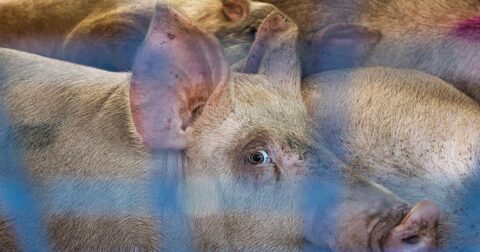Solutions
Chipotle’s Founder Is Betting on Plant-Forward Food
Food•2 min read
Reported
36 new factory farms are slated to open in Ireland, pending approval from the Irish EPA.


Words by Sophie Kevany
Applications for 36 new intensive pig and poultry farms and expansions are pending approval in Ireland, changes that would add millions of animals and compound existing problems with manure, ammonia and animal welfare management in the country. The predicted sharp rise in factory farms has alarmed environmental advocates and animal rights watchers.
Studies show almost all of Ireland’s ammonia emissions come from animal agriculture, and one of the key sources is manure. If approved, up to 12 million more chickens and 55,000 more pigs would be industrially reared in the country, producing a potential 53,000 cubic meters of excrement annually – the equivalent of 97,000 people, almost the population of Limerick city.
Of the 36 applications, 26 are for poultry and 10 for pig units. More than half are located in Monaghan and Cavan, counties that are already struggling with excess manure.
The figures were compiled from public documents submitted by applicants to Ireland’s Environmental Protection Agency in Ireland. For poultry, animal estimates were calculated by multiplying the proposed increase by the number of flocks reared and slaughtered per year and, for pigs, the average number of piglets born per year. Data from Cornell University researchers was used to calculate the number of people to produce the equivalent waste.
The applications, still open to public objection, are pending approval by the EPA. They cover both enlargements of existing pig and poultry houses and new builds that would house over 40,000 poultry, 2,000 pigs or 750 sows.
EPA data shows the agency rejected only a handful of applications over the last 20 years, suggesting all of the operations have a good chance of being approved. This year, 17 pig and poultry permits have already been granted.
The detrimental impact that intensive farming can have on animal welfare is well documented. A 2018 EU report found a range of problems, while a separate study found that cutting piglets’ tails off, a practice forbidden by E.U. rules, is routine in Ireland. Activists says other abuses include teeth clipping and caging of sows.
Poultry risks include overcrowding in sheds and cages, leg and other bone problems as well as skin damage from ammonia in their litter. This year, Ireland has also been hit by outbreaks of Avian Influenza.
Caroline Rowley of Ethical Farming Ireland condemns the proposed increases. “The message the government is supposed to be giving is reduce our consumption of animal products, not increase it. How are we going to meet our emissions reductions targets by increasing the number of farmed animals?”
“The vast majority of birds are reared indoors in overcrowded conditions and with the rise of avian flu outbreaks every year even free-range birds are confined inside barns,” Rowley says, while Irish pigs “endure a life of misery and despair.”
“It would seem,” she adds, “that getting the existing house in order would be a wiser move than permitting even more intensive factories with appalling animal welfare standards dependent on antibiotics to keep animals alive until slaughter weight is reached.”
Ireland’s industrial farm sector has expanded rapidly on the back of controversial government plans to turn the island into a global meat and dairy supplier.
Over the last five years since 2018, numbers of EPA permits for intensive pig and poultry units have grown by 34 percent to 340 as of December this year. The country is now home to just over 1.6 million pigs, while over 70 million chickens are produced annually, along with four million turkeys and eggs are laid by two million hens.
In an email one of Ireland’s leading climate scientists, Emeritus Professor John Sweeney, described the proposed increase in intensive pig and poultry production as “especially concerning” given that Ireland’s ammonia emissions “have been non-compliant [with EU limits] for 7 out of the last 9 years.”
One way to better protect human and ecosystem health from excessive ammonia, Sweeney said, was to consider limiting financial farm supports for further intensification. “[T]he continuation of business as usual is not acceptable,” he added.
Ammonia pollution is linked to soil acidification and leaf damage, leading to plant species declines. In freshwater it can kill fish and other marine life because it encourages algal blooms, oxygen depletion and acidification, a process known as eutrophication.
Direct damage to people from ammonia includes eye and lung irritation. Ammonia also helps the formation of tiny particles known as PM2.5 which cause air pollution and respiratory problems.
Existing problems with manure management are another factor weighing against any increase in intensively farmed animals, says Elaine McGoff of An Taisce.
“The EPA gives the license but as soon as the slurry or the litter from the poultry sheds leaves the farm gate, the responsibility passes to the department of agriculture,” she says. “To date, there is a significant lack of transparency over where that slurry or litter goes.”
Imported grain used to feed animals on intensive pig and poultry farms is another concern, says McGoff. “The war in Ukraine has put huge pressure on grain supplies, driving prices up globally, and we’re now seeing countries in Northern Africa that depend on imported grain for human food no longer able to afford it, further exacerbating the impacts of the drought induced famine.”
McGoff further suggests that producing more chicken and pork was not helpful either. “There has been a range of studies demonstrating that switching to a more plant-based diet, as proposed in the EAT-Lancet report, is better from a food security perspective, and could significantly improve food system resilience in light of the global crisis, such as the Ukraine war.”
In an email the EPA said since it began licensing intensive farms in 1996, seven applicants had been refused, although some licenses issued “may authorize fewer intensive agriculture animal units than originally sought by the applicant in the license application based on the EPA’s assessment of environmental impacts.”
Asked about manure disposal beyond the farm gates, it said the agency was “only responsible for the activities within the boundary of the licensed activity.” To limit on-premises ammonia emissions “[a]ll EPA licensed installation must implement BAT [best available techniques] which requires the reduction and control of ammonia emissions,” it said.
The email went on to say that as part of the licensing process “all applicants must provide information that poultry litter is transported [off the premises] either by the applicant (or staff member) or by an authorized haulier registered with” Ireland’s Department of Agriculture, Food and the Marine (DAFM), and that “records, must be maintained of any organic fertilizer sent offsite and must be notified to DAFM annually, in accordance with the Nitrates regulations.”
The EPA email said records covering the “landspreading [of farmed animal manure] are maintained by the Department of Agriculture, Food and the Marine (DAFM).”
The email added that “[d]ue to a high volume of intensive agriculture applications/reviews and licenses” it had published new guidance on how applicants close to protected Natura 2000 ecological areas should assess ammonia emissions.
For applicants near protected sites, and where “background levels already exceeded for the ammonia critical level” further assessments are required.
The EPA said the new guidance has had “significant implications for the assessment of new and reviewed license applications within 10km of a number of Natura sites” and that “no new licenses have issued and cannot until the overall background levels of ammonia and nitrogen deposition reduce.” The agency also said that its licensing decisions are made in light of the agriculture department’s climate and environmental guidance. These contain a broad range of ammonia-cutting measures including reducing protein in feed.
The DAFM did not respond to questions or a request for comment.
Brendan Guinan, an Irish regenerative farmer with pigs, cattle, chicken and forestry, said the thought of more industrial farms left him both indifferent and sick to his stomach. Indifferent because “no matter what you do, it’s impossible to fight” and sick because instead of adding industrial farms, “Ireland could be a genuine green, not green-washed, country with energy and with food.”
Intensive agriculture’s foundations are eroding, says Guinan. “[I]t is built on a house of cards. You can’t farm industrially without antibiotics and creating [antibiotic] resistance, without degrading soil, without cheap oil, without the carbon emitting concrete for buildings, without cheap money,” he says. “And all those things are stacked against [industrial] farming now.”
This post has been updated for clarity.
This story is a joint publication by Sentient Media and Noteworthy.